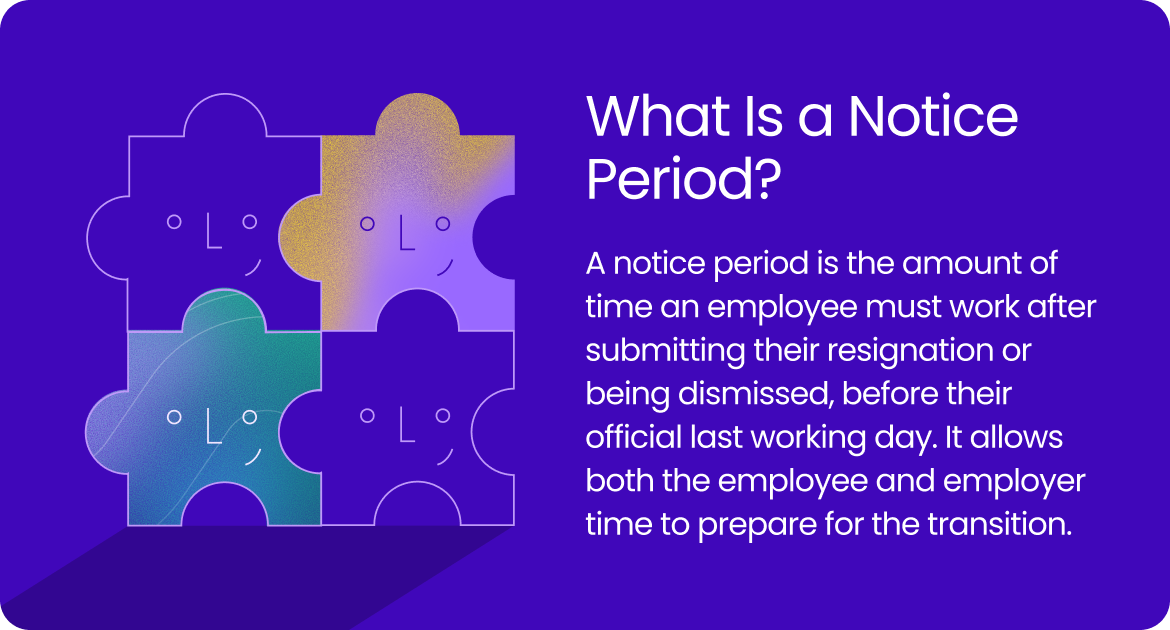A notice period is the amount of time an employee is required to give before they leave their job. This period can vary depending on factors like the employee's role, their contract, and even where they are located in the world. They’re important because they give both the employer and employee time to prepare for the transition. Whether it’s finding a replacement, tying up loose ends, or making sure knowledge gets passed on, the notice period helps keep everything moving.
But it’s not without its challenges. Navigating through different global regulations, managing employee engagement during this time, not to mention the paperwork – it can all get complicated quickly.
This guide will go over everything you need to know about notice periods, from regulations in different countries to practical tools that can make the process easier, we’ve got you covered.

Types of Notice Periods
There are a couple of different types of notice periods that an employee can give, each of which serves a particular purpose:
- Statutory Notice Period: This is the legally required notice period, which can vary depending on the country.
- Contractual Notice Period: Some employment contracts specify a longer notice period when it comes to more specialized roles that could take multiple months to replace.
- Probationary Notice Period: During probation, the notice period may be shorter or even waived altogether. This creates a sort of escape clause for both employers and employees if either feels the match isn’t quite right.
- Payment-in-Lieu Notice Period: Sometimes an employee and employer agree to end the relationship early, with the employee receiving payment for the notice period instead of working it.
Global Overview
Notice period laws differ widely across the globe, so it’s important to know what’s required by local labor laws in each country where you operate. Notice period practices can also differ significantly depending on cultural expectations. For example, in some Asian countries, employees in senior roles may be expected to give longer notice periods compared to Western countries, where the norm is often shorter.
Here’s a brief comparison of the minimum statutory notice periods across key countries:
Global employers should curate their notice period policies to reflect the cultural expectations of each region. This can help avoid misunderstandings and create a more attractive and balanced workplace.
Best Practices for HR Managers
You have the power to make sure any transition in your organization runs smoothly for everyone involved if you manage notice periods well. Handled poorly, it can lead to major disruptions, unhappy employees, and even costly legal problems.
You need to stay proactive, keep the lines of communication open, and make sure the whole process feels professional and clear. Here are some simple best practices to help everything go smoothly during this time:
Document Your Policies
Clear and well-communicated policies will make sure everyone knows what to expect when the time comes. Be sure to outline the notice period in both the employee handbook, and employment contracts, and make sure they reflect both statutory and contractual notice requirements.
Communicate Clearly
Keep communication open and transparent. Explain your notice period policies during onboarding and once again when an employee submits their resignation.
Do Proper Handovers
The notice period is a great time to make sure knowledge transfer and handovers are done properly. You can help by coordinating the exit process and scheduling training sessions for replacements.
Use HR Software
HR software tools like Playroll’s HR solutions, Lanteria, BambooHR, and Dayforce can be a lifesaver when managing notice periods. They can automate notifications, keep track of deadlines, make sure you compliantly offboard your talent, and handle the documentation for you.
Common Challenges With Notice Periods
Managing notice periods can be tricky for employers. From handling unexpected resignations to keeping morale of the rest of the team up. Here are some of the most common challenges and tips to tackle them:
1. Employee Leaving Before the Notice Period Ends
Employees sometimes leave before completing their notice period, leaving employers scrambling to fill the gap and potentially dealing with a messy and incomplete handover.
Tip: To avoid this, consider having clear clauses in your contracts that outline the consequences of leaving early. Keeping open communication with employees during their notice period can also help keep your employees committed to the full term.
2. Difficulty Managing the Transition of Duties
During an employee’s notice period, it’s often tough to manage a smooth transition or handover of duties, especially in leaner teams.
- Tip: Plan for the worst case-scenario before it happens. Start cross-training other team members early in the employee’s tenure. So that if someone does leave, another team member will be able to step in to pick up their duties.
3. Keeping the Morale of Remaining Employees High
When an employee leaves, it can affect team morale, especially if they carried a particularly important part of the team workload or were well-liked .
- Tip: Ensure remaining employees feel valued and involved in the transition. Acknowledge the contributions of the departing employee and reassure your team about their role in the company’s future. Open communication and support are key.
4. Unexpected Delays in the Handover Process
Sometimes, employees don’t complete their handover as expected, leading to delays and confusion after they leave.
- Tip: Create a structured handover process that includes detailed documentation and regular check-ins with the departing employee. Assign someone from the team to oversee the process and ensure everything is completed quickly and comprehensively.
5. Ensuring Compliance with Local Laws
Different regions have different laws surrounding notice periods, which can create legal complexities.
- Tip: Always stay informed about the employment laws in the regions where you operate. Consider consulting with an HR specialist to ensure that your contracts and practices align with local regulations.
6. Managing the Emotional Impact on the Team
Your team might feel upset or disengaged after learning about a colleague’s departure, especially in close-knit teams.
- Tip: Encourage open dialogue and offer support to employees affected by the departure. Sometimes, a team-building event or an informal meeting to discuss concerns can help alleviate any negative emotions.
7. Managing Difficult Notice Periods
When an employee leaves under more complicated or difficult circumstances, managing the notice period can be incredibly challenging. Here are a couple of things to keep in mind when the resignation process isn’t exactly straight forward:
- Tip: It’s important to make them feel valued during their final weeks, and give them any support they need for a smooth transition. Clear documentation of their processes and tasks, as well as encouraging them to share important knowledge with their replacement, can help keep things on track and prevent any workflow disruptions.
What is a Notice Period Buyout?
Sometimes, employers and employees may agree to skip the notice period altogether, either by paying the employee to leave earlier (payment in lieu) or offering a garden leave (a paid leave during the notice period).
When this commonly happens:
- Sensitive Roles: For sensitive positions like executives or employees with access to confidential information, a garden leave might be preferred to prevent any company knowledge being leaked before your employee’s official last day.
- Speed Up Transition While buyouts can be costly, they may be necessary to accelerate an employee’s notice period to avoid them causing any disruptions in your team.
Legal Considerations for Buyouts
Make sure to follow relevant local laws when considering buyouts. In some jurisdictions, payment in lieu of notice is required, while in others, it may be more flexible.
Always weigh the financial impact of either option before making any concrete decisions.
Playroll helps you onboard and manage international employees in over 180 countries, all while staying fully compliant with local laws.
Speak to an Expert
Notice Period FAQs

.png)
Notice periods are typically calculated based on the employee's length of service and the terms of their contract. Some countries also have statutory requirements that dictate the minimum notice period.
.svg)
.svg)
.svg)
.svg)
.svg)





.svg)




.svg)



















.svg)